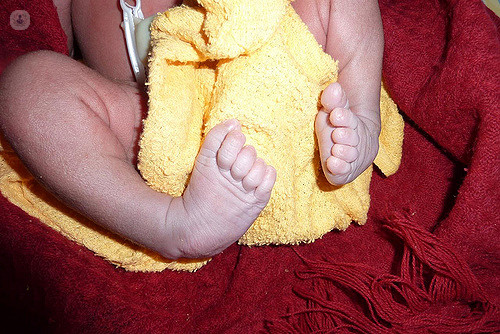


What is club foot?
Club foot is a birth defect in which the baby’s foot or feet are twisted out of shape or position, usually pointing downwards and inwards, with the sole facing backwards. It is relatively common – around 1 in every 1,000 babies in the UK is born with club foot. In around half of those affected, the condition is present in both feet.
Prognosis of club foot
Club foot is treatable, and it is recommended to do so – if left untreated, it can become painful as the child grows up, and can impair their ability to walk. This can mean an awkward gait due to having to adjust to walking on the ball or outside of the foot, and these adjustments can have other negative effects, such as sores, calluses, and impaired growth of the calf muscles. It also makes the child more likely to develop arthritis.
Even if treated, the child may still suffer effects – their movement may be slightly limited, their calf muscles on the side affected by club foot might be smaller than the other side, and the affected foot may be a smaller shoe size.
Symptoms of club foot
The main symptom is the appearance and this is usually how a doctor will notice and diagnose the condition. Feet affected by club foot are usually shorter than other feet, and can be twisted so much that they appear to be upside-down.
Another symptom is that the calf muscles in affected limbs are underdeveloped.
Despite all this, club foot does not appear to cause babies any pain; however, treatment is recommended as it can become painful later when the child learns to walk.
Medical tests to diagnose club foot
While club foot is clear to see when the baby is born, it may be diagnosed before birth if seen on an ultrasound scan. While it can’t be treated until the baby is born, knowing what to expect can help the parents plan treatment.
What are the causes of club foot?
The causes of club foot are poorly understood, but there may be a genetic component, as it seems to run in family.
Treatments for club foot
Treatment for club foot is largely physical. The standard method is the Ponseti method. This involves gently working the foot into a more natural position, then putting it in a cast for a week, and repeating the next week. This usually goes for between 5 and 8 weeks.
Most babies need a minor operation to loosen the Achilles tendon after the final cast comes off. The operation is performed under a local anaesthetic.
To prevent club foot from returning, the baby must wear special boots with a bar to hold them in position for the first 3 months, and then only at night until they are four or five years old.
Which type of specialist treats club foot?
Paediatricians specialise in diagnosing and treating conditions in babies and children. Paediatric orthopaedic surgeons in particular specialise in musculoskeletal conditions such as club foot.
